Hiroshima Mihara Trip.
On the second day, we will participate in the monitor tour organized by the Mihara Tourist Association, which is the main purpose of this trip.
The tour starts with an octopus jar fishing experience.
Mihara City in Hiroshima Prefecture is famous for its octopus. The octopus is caught using the traditional method of octopus jar fishing, which has been passed down from generation to generation since the Edo period.
I have fished for octopus before, but this was the first time in my life to see octopus fishing up close.
Moreover, it was a valuable experience for me to see up close the octopus jar fishing method, which is not widely practiced in other areas.
All of the octopuses that were caught were large in size.
The currents off Mihara in the Seto Inland Sea are very fast, and the octopuses that live there have tighter bodies and thicker legs.
The octopus moves faster than expected, and the skillful rudder work of the fisherman piloting the boat, the boat rocking firmly, and the splashes flying …….
Everything I saw was new and fresh, and I was able to experience it with my whole body, so it left a strong impression on me.
In this article, I will describe the octopus jar fishing experience, using many photos to convey the atmosphere of the fishing.
Participating in a monitoring tour organized by the Mihara Tourist Association!
On the first day of my trip to Mihara, I went to the remote island of Sakijima and toured shrines and temples around Mihara Station, as I felt like it.
In the evening, we went to “Rikubunsen Izakaya”, a pub in downtown Mihara, where you can enjoy dishes made with local ingredients.
I enjoyed Mihara in my own way.
On the second day, we were going to participate in a monitoring tour organized by the Mihara Tourist Association.
Participation in the tour was the main purpose of this trip.
The tour was designed to fully enjoy Mihara’s famous octopus, including the opportunity to enjoy a variety of octopus dishes served at various restaurants in Mihara City, as well as to experience traditional octopus jar fishing.
Departing from the Mihara City Fishery Cooperative Association to the octopus jar fishing grounds
8:00 am.
After gathering in front of Mihara Station, we were picked up by car and driven to the Mihara City Fishery Cooperative Association.
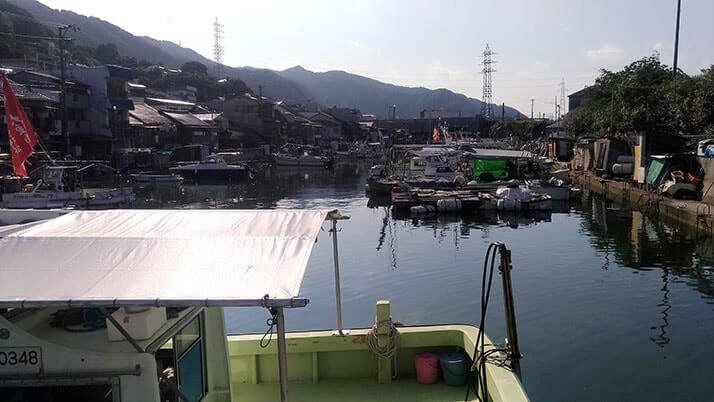
We will depart from the harbor right in front of the cooperative building for the octopus jar fishing.
We were told that we would get wet when lifting the octopus jars and from splashing waves, so we should wear a kappa and boots. In addition, a life jacket.
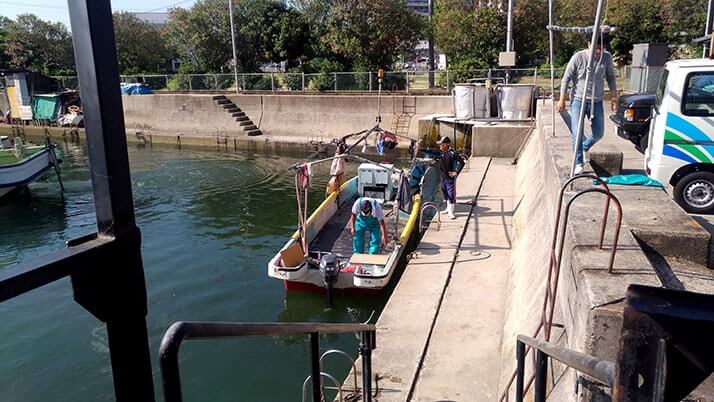
Only 10 minutes after departure from Mihara Station, we were already ready to board the boat.
This time, we were allowed to board the boat with the union president himself at the helm.
At first I thought it was early in the morning, but when I asked him about it, he told me that during the actual fishing season, the boat leaves at midnight and returns in the morning.
The captain said, “We decided on this time for this tour.
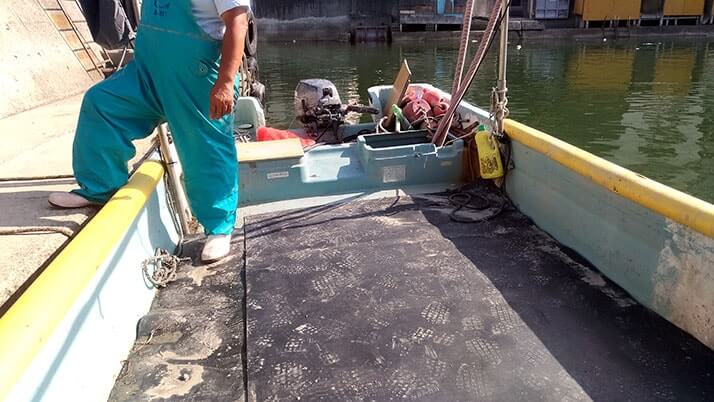
The boat was smaller than I had imagined.
I often fish, but I had never fished from a boat before, so this was my first time on a boat of this size. From the very beginning, I was excited to experience it for the first time.
A total of six people boarded the boat: two fishermen, one person from the tourist association, and three monitors including myself.
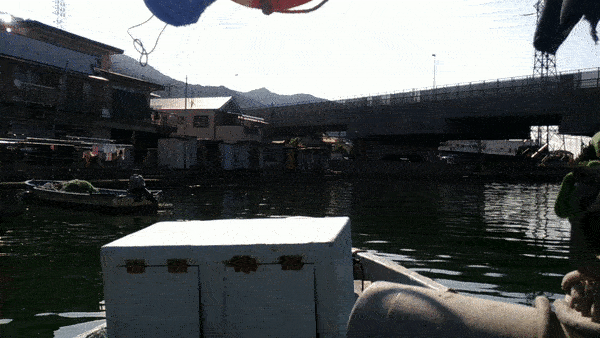
Now, it was time to set sail!
When the boat started moving, we were asked to sit on the edge of the boat. This was also a new experience for me.
For a moment, I thought I might fall off if I sat on the edge, but I was surprised to find that it stabilized my body.
The viewpoint becomes lower, so it is as if you are gliding on the sea. It was an interesting experience, all fresh and new even before the fishing!
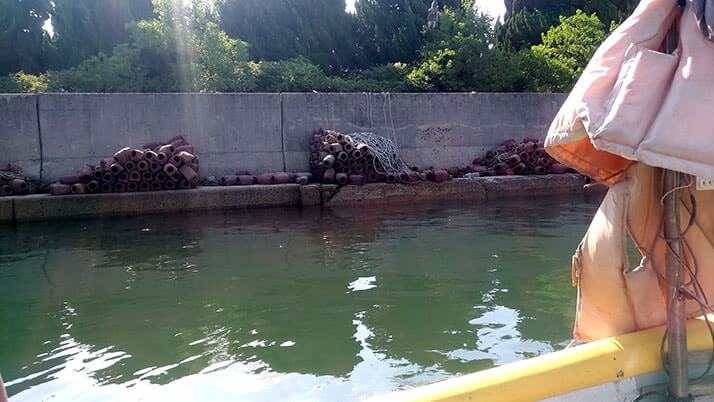
Octopus pots are placed on both sides of the channel. You rarely get a chance to see octopus pots lined up in a row.
This scene clearly shows that octopus pot fishing has taken root in this area.
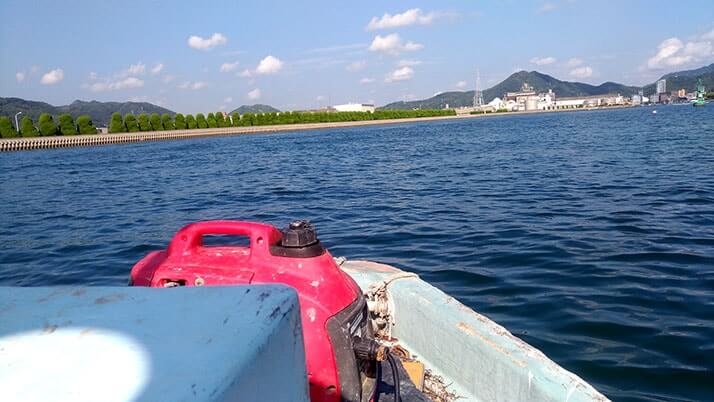
The fishing grounds are in Mihara Bay (Seto Inland Sea).
The boat is small, so it is greatly buffeted by the waves. It was a hot day, so the breeze was nice and cool, but I could imagine that the fishing must be especially tough during the cold season.
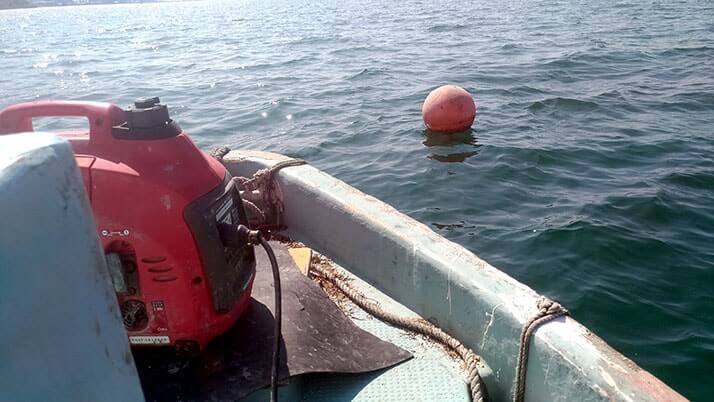
Once we arrived at the fishing grounds, we went to the buoys attached to the ends of the octopus traps.
In Mihara’s octopus pot fishery, buoys are not attached to the traps. The fishing grounds are passed down from generation to generation, and the locations of the two ends and the center of the traps are determined from the locations of islands and mountains.
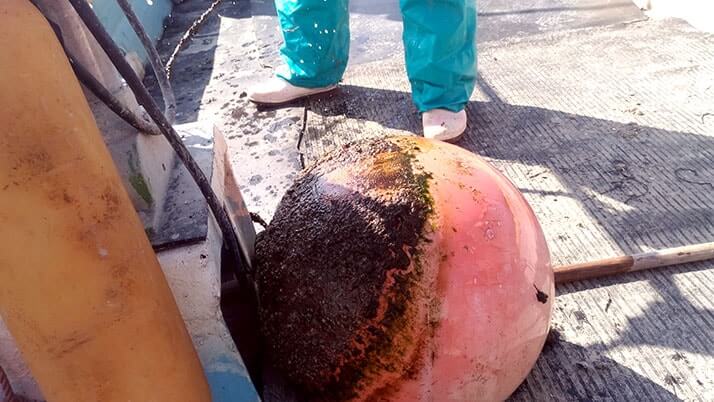
This time, the traps were made with the method of attaching buoys.
For the aforementioned reasons, buoys are rarely seen in Mihara Bay, but there are many octopus pots set up on the seafloor that are not noticed by the casual observer. Bottom trawling is banned in this area.
Scene of octopus pot fishing|Retrieval side
After pulling up the rope with the octopus pots attached, the octopus pot fishing begins.
In octopus jar fishing, two fishermen ride in pairs on a small boat, with one person at the helm and one person retrieving the traps.
First, let’s take a look at the trap retrieval side.
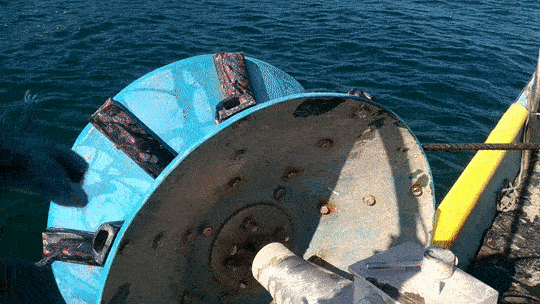
The rope with the traps attached is hoisted up using a roller that rotates automatically.
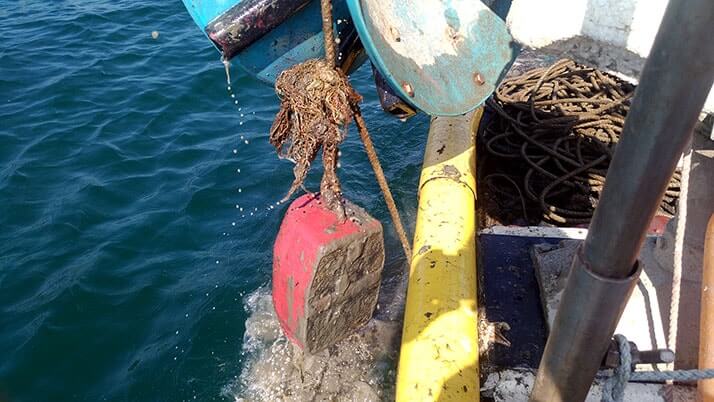
The distance between octopus pots is about 10 meters.
The depth of the water at the location where the octopus pots were set this time was about 8 meters. They say that the depth should be shallow during the hot season and deep during the cold season to make it easier to catch octopus.
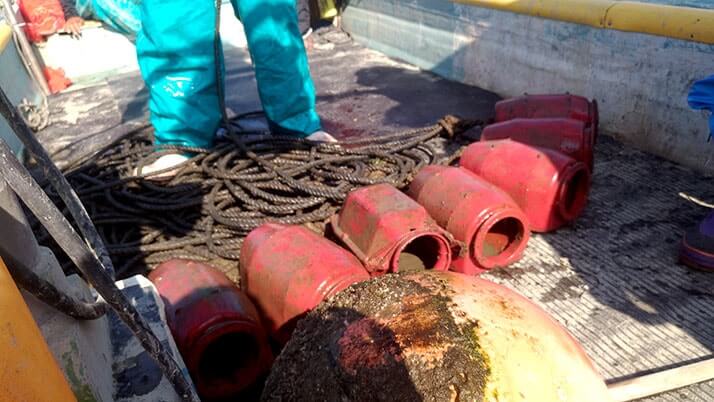
One after another, octopus pots were being landed on the boat.
There are 80 to 100 octopus pots attached to each trap. The length of the rope is said to be as long as 1,000 meters.
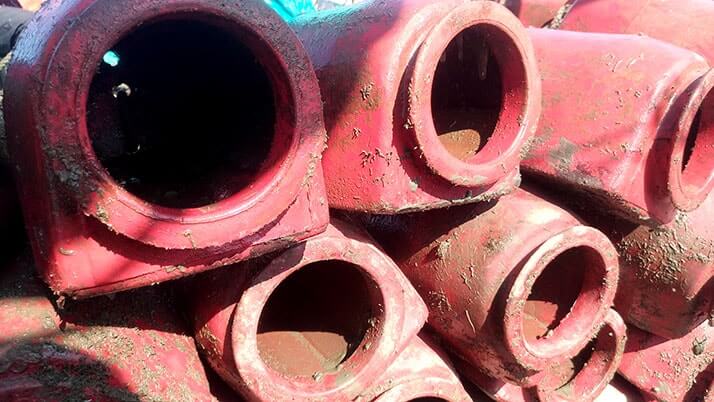
After all the octopus pots are lifted on board, they are immediately set on the ocean floor.
Therefore, the octopus pots are neatly stacked after being lifted onto the boat.
I had an image that the octopus pots were made of unglazed pottery, but all the octopus pots are made of plastic, each weighing about 1 kg.
Each octopus pot weighs about 1 kg and has a weight underneath to ensure that it is set in the correct direction. The octopus pots have been improved upon over and over again, and this shape is the result.
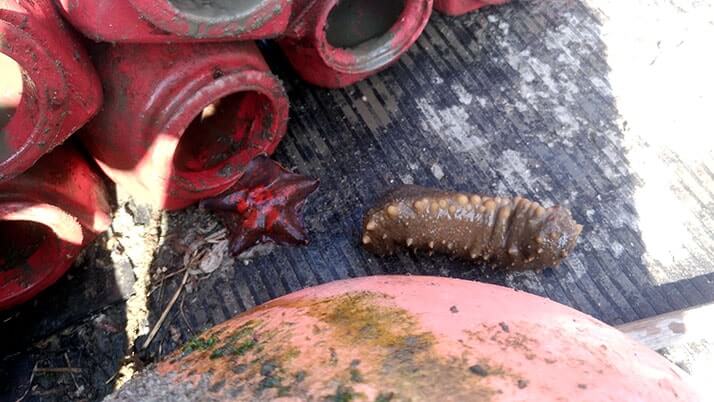
In addition to octopuses, the octopus pots are also home to other intruders such as starfish, sea cucumbers, and octopuses.
Starfish, sea cucumbers, crabs, and other creatures have attached themselves to the octopus pots and have been fried on the boat.
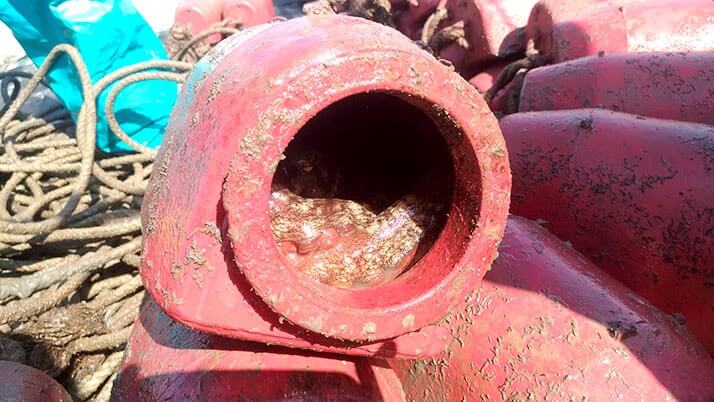
There was even an octopus in there! This is the first time I have seen an octopus in an octopus pot.
On this day, there was an octopus in about 10% of the octopus. When there is a lot of octopus, they catch 70 to 80%.
The amount of octopus caught seems to depend on the weather, and the cooperative head told us that when there is heavy rain and water comes from the mountains, the octopus are in good shape.
There is no bait in the octopus pots, but the pots provide a good hiding place for the octopus in the sea, so the octopus willingly enter the pots.
It is a fishing method that makes good use of the octopus’s habit.
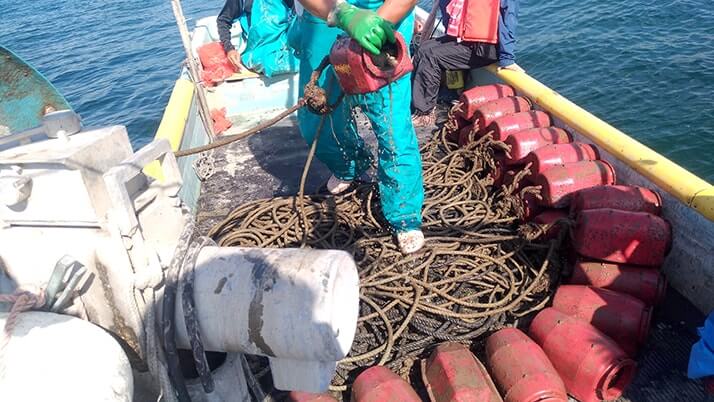
The jar containing the octopus is handed to the fisherman on the helmsman’s side at the rear of the boat, who removes the octopus from the jar.
Now let’s take a look at the fishing from the helmsman’s side.
*This is a video of octopus jar fishing. Please watch it as well!
Octopus Jar Fishing|The Quartermaster’s Side
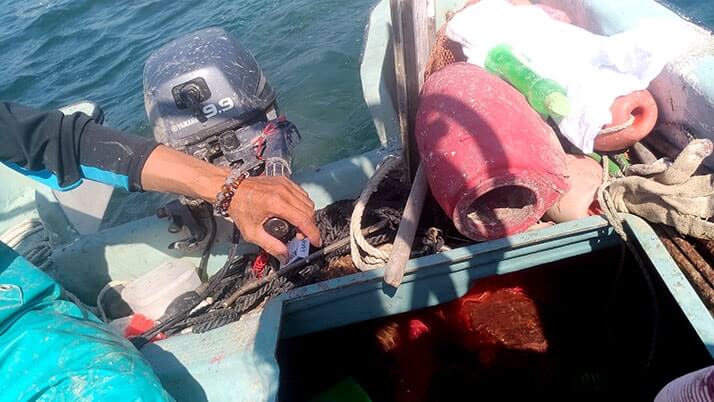
We have now moved to the helmsman’s side.
Here, the union leader skillfully maneuvers the boat at the helm.
The position of the boat is also adjusted little by little when the octopus pots are being hauled up and when the octopus pots are being set. This kind of fishing is only possible when the retrieving side and the steering side are in sync with each other.
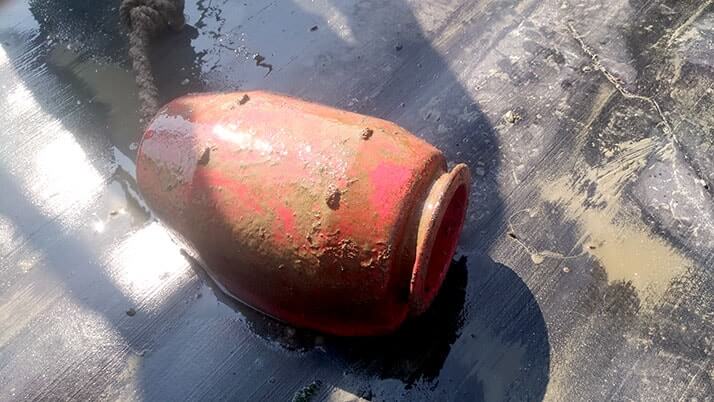
Now, this octopus pot has an octopus inside.
If the octopus is found in the octopus jar that was pulled out, the jar is handed over from the trap collector to the helmsman.
The octopus may come out of the jar by itself even if it is left in place, but there is a way to remove the octopus from the jar immediately.
That method is to hit the jar with a stick.
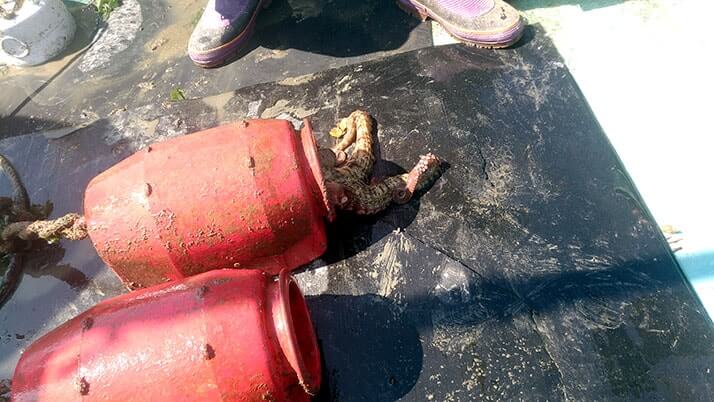
After a while of hitting the octopus pot with a stick, the octopus will come out gnawing, probing the outside of the pot with its legs.
The octopus is said to be sensitive to sound and comes out startled.
Another way octopuses are startled into coming out is by pouring thick salt water through a hole in the back of the octopus pot.
I learned about this for the first time when I saw it in front of me on this day. It is interesting, isn’t it?
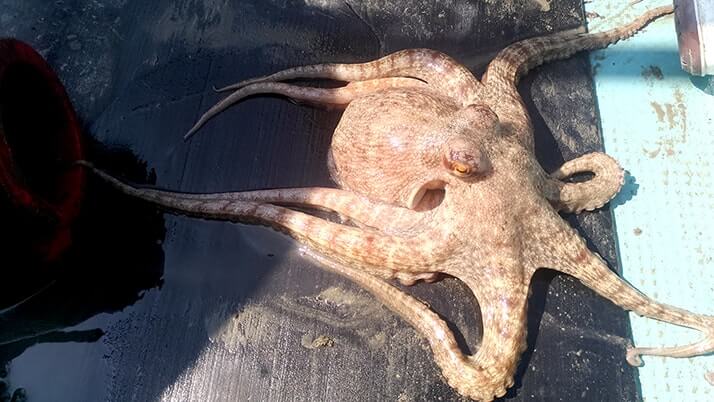
Once out of the octopus pot, the octopus runs away at an unexpectedly fast speed.
I had expected octopuses to move more slowly, so this was unexpected!
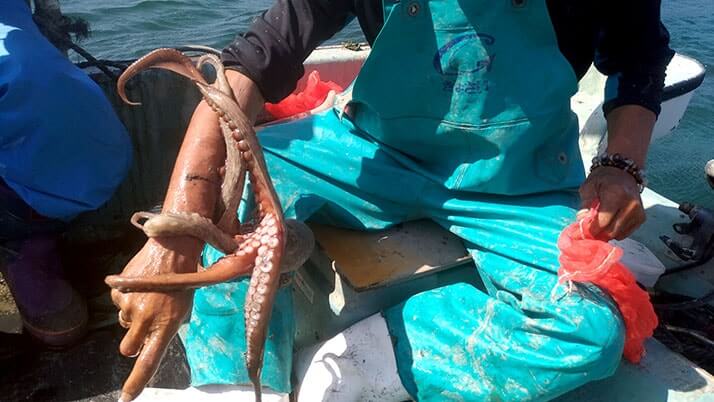
The octopus was full of energy because it had only been in the octopus pot. It resists with all its might to avoid being put in the net.
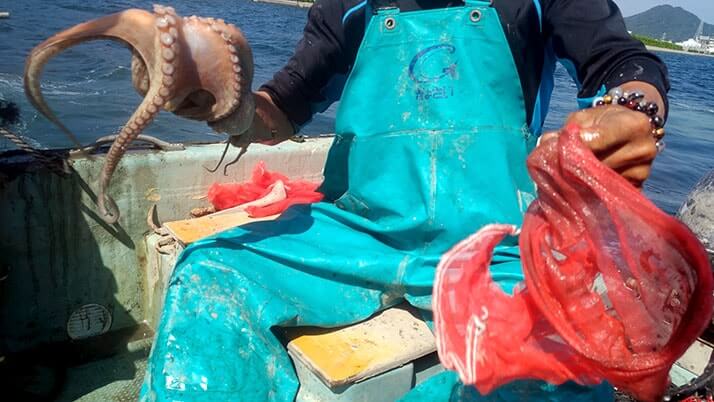
When you put it in the net, you hold the octopus by the head and throw it in through the legs.
This action is so dynamic and exhilarating to watch.
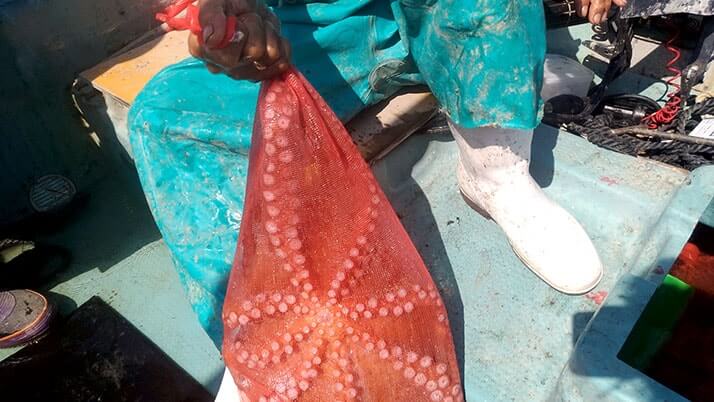
The currents off Mihara in the Seto Inland Sea are so fast that the octopuses that live there are said to be able to withstand the currents and stick to the rocks.
Therefore, octopuses trained by the ocean currents have thick legs and firm flesh. All the octopuses that are landed are large in size.
Unlike bottom trawling and fishing, octopus caught in octopus pots do not get any damage to their flesh, so the advantage is that the octopus can be landed in a clean condition.
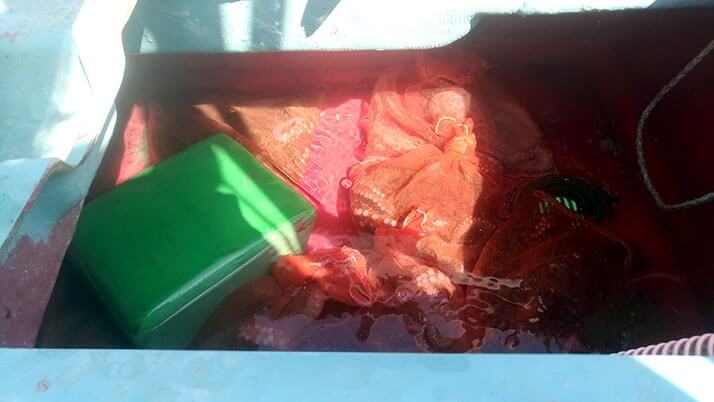
After octopuses are taken out of the pots, they are placed one by one in nets and kept alive in the kesu, which is attached to the boat.
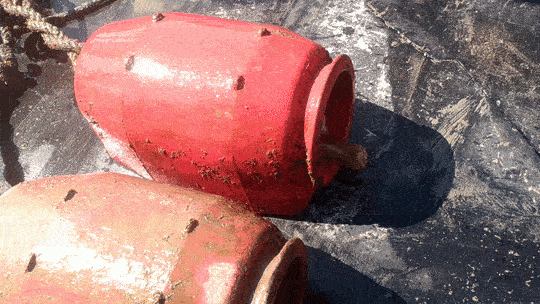
Watching the octopus emerge from the octopus pot is interesting no matter how many times you see it.
It is an enjoyable experience because you have never seen an octopus in such close proximity.
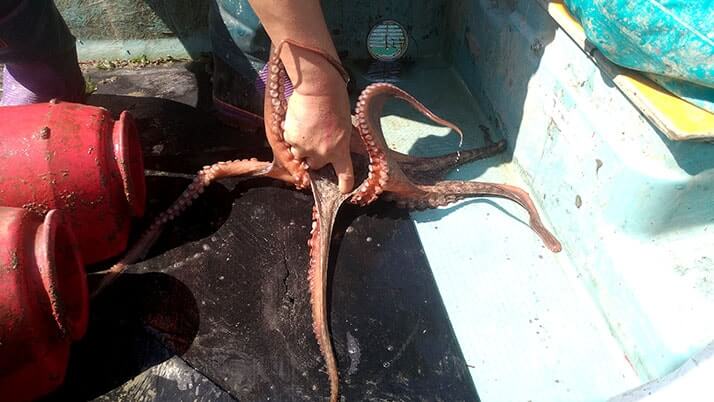
Incidentally, if someone who is not used to handling octopuses tries to catch them, the octopus resists and is difficult to lift.
The force of the octopus’s suckers is quite strong, and as a mollusk, it is very hard for the octopus to resist your hand.
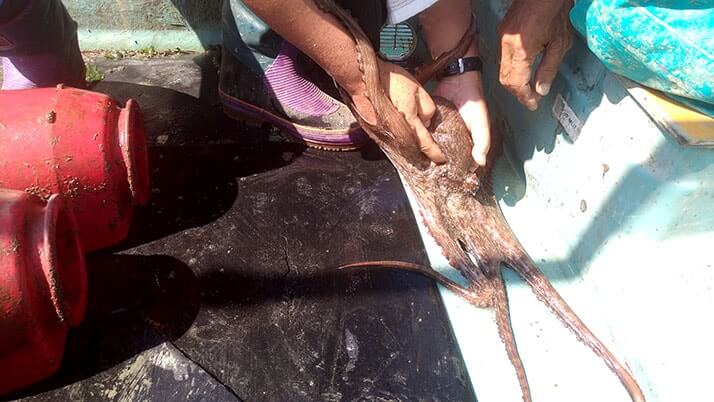
According to the union leader, when an octopus resists by attaching its suckers to you, it is easier to catch it if you pull in the direction the octopus is moving, rather than trying to peel it off.
This is trivia knowledge when catching octopuses.
Retrapping the octopus jar in the sea and returning to port
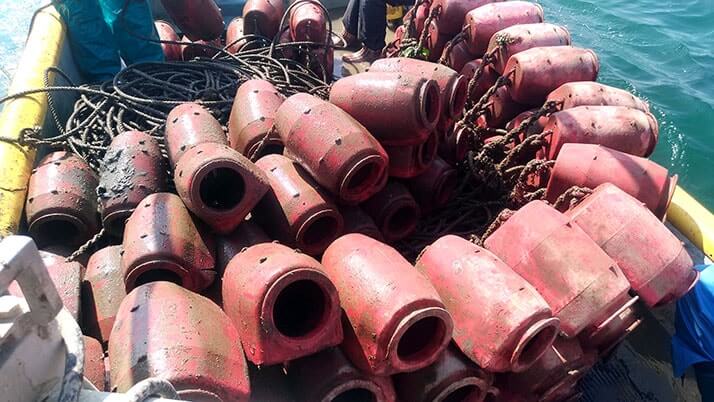
After the traps were taken in, the small boat was filled with piled up octopus pots.
After all the octopus pots are fried, the jars are set back into the water without a moment’s rest.
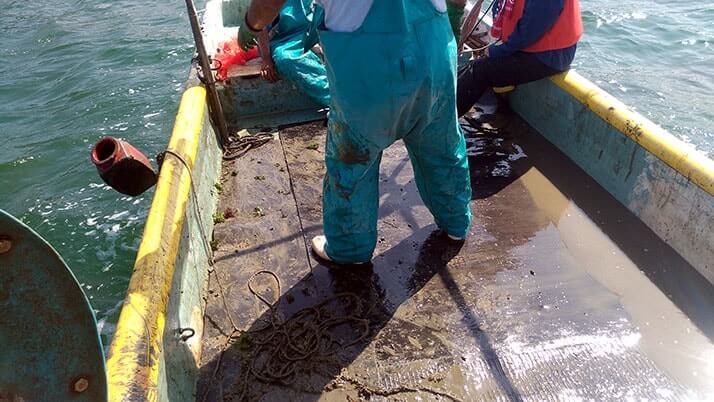
After two more traps were hauled out and placed back in the water, the day’s octopus pot fishing was over.
We returned to the harbor in front of the Mihara Fishery Cooperative Association.
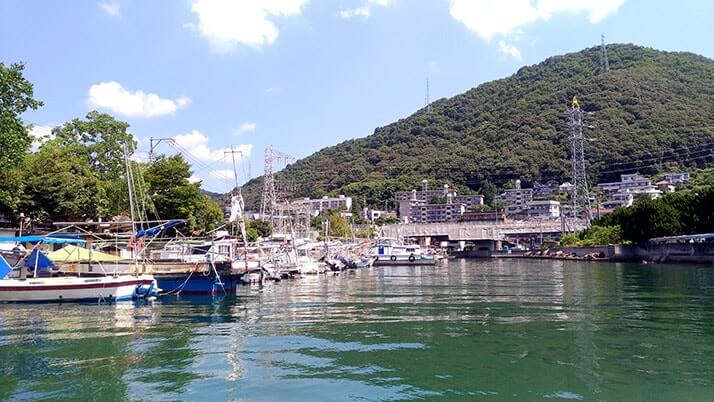
The octopus jar fishing experience allowed us to see the entire fishing process up close and personal.
Fishing is a tradition that has continued since the Edo period and is backed by many years of experience. The fishing has been passed down from generation to generation through a hereditary system, which has enabled the fishermen to coexist with the octopus without catching too many octopuses.
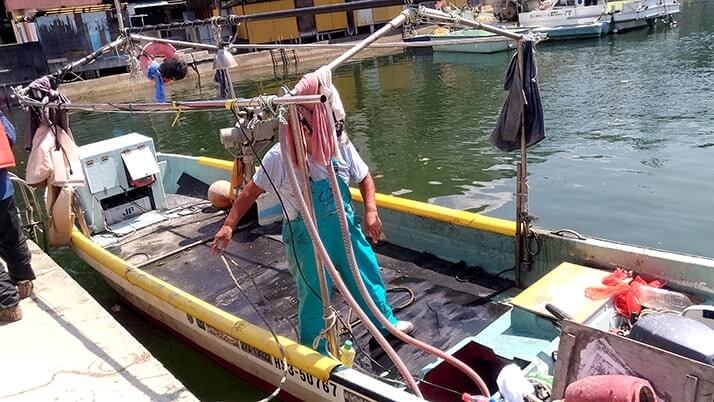
After arriving at the harbor, the fishermen clean the inside of the boat.
Sand and mud come out of the octopus pots, so the inside of the boat gets quite dirty.
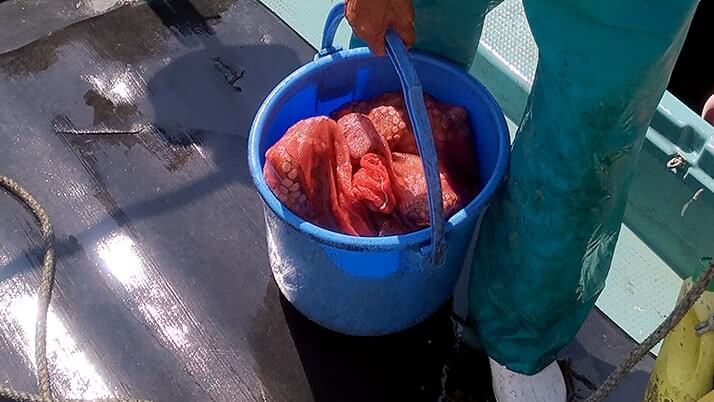
The caught octopus are placed in a large bucket and landed.
The fishermen lifted them easily, but each octopus was so large that they were extremely heavy. I had to hold it in both hands and crab around with both hands.
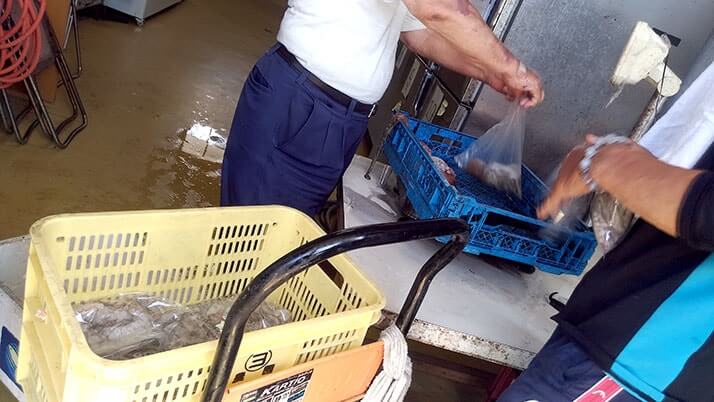
The Mihara City Fisheries Cooperative Association manages the fishery and also processes and sells fishery products. The octopuses that had just been brought from the boat were being put into bags one after another.
When I caught an octopus while fishing, I used to wash it in fresh water and rub it with salt to remove the sliminess after it was shucked, but here the procedure was completely different. I learned a lot.
First, the octopus is rinsed in salt water. I was told that if the octopus comes in contact with fresh water, the flesh will blister.
Furthermore, they do not rub the octopus with salt, but freeze it as it is. The octopus is then placed in a bag and vacuum-sealed.
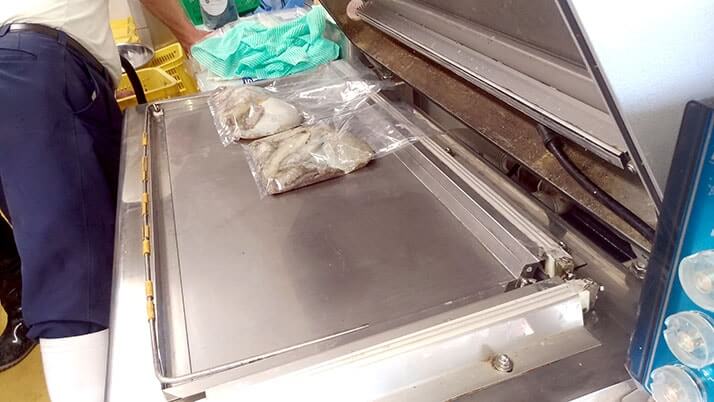
The bagged octopus is vacuum-packed and then flash-frozen.
The freezing process helps to remove the sliminess of the octopus. The flavor is retained and the flesh becomes softer and easier to eat, among other benefits.
The Mihara City Fisheries Cooperative Association has branded this octopus as “Mihara Yassa Octopus” and sells it.
The octopus is vacuum-packed and then flash-frozen, so it can be eaten as if it were freshly caught at the destination.
Conclusion
In Mihara, Hiroshima, traditional octopus jar fishing has been passed down from generation to generation.
I personally enjoyed this event more than enough, not only for the experience but also for the knowledge. It was a valuable experience for me to be able to accompany and witness the whole process of fishing, which is not something I get to see very often.
After the octopus jar fishing, we decided to have “Mihara Yassa Octopus” at the Mihara City Fishery Cooperative Association.
We were served octopus sashimi, octopus tempura, and octopus rice, all of which were exquisite! I will write about the meal in my next article.
Here is a video of the octopus jar fishing. Please watch it as well!

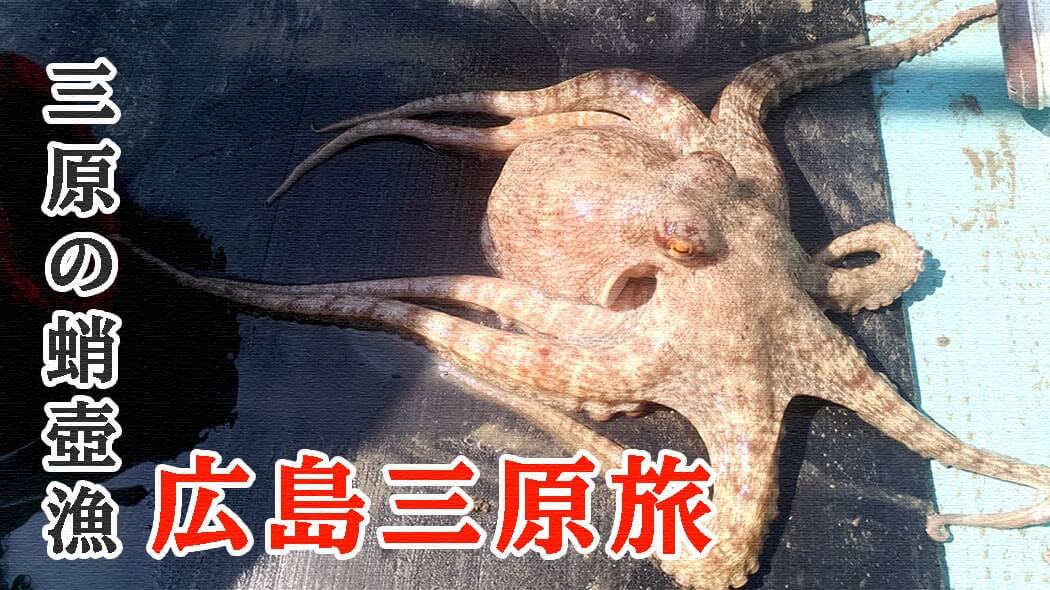






コメント